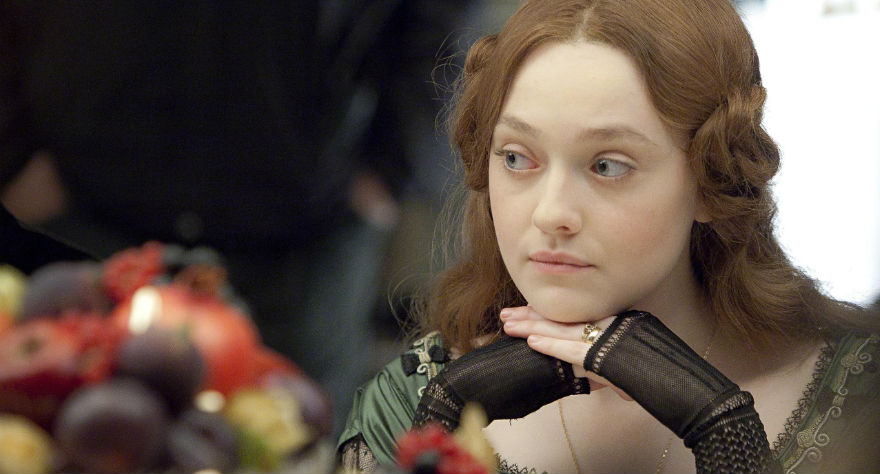
A dirge-like film that strips an inspirational true story of all life and drama.

A dirge-like film that strips an inspirational true story of all life and drama.
Effie Gray is a 19th century period piece that wants to be about feminism and female independence in the Victorian era, but the road it takes to get to its central message is so long and lonesome that, simply put, it winds up being too dull an affair for us to care. Dakota Fanning—the once exceedingly precocious child actor who’s recently found her footing as a mature, refined thesp—plays Euphemia “Effie” Gray, a sad girl stuck in a sad situation. In 1848 the 19-year-old Gray married John Ruskin (Greg Wise), one of the most eminently lauded and biting art critics of the era. Before they were wedded, Ruskin wrote a fairy tale inspired by Gray called “The King of the Golden River” (they met when Gray was only 12); unfortunately, what became of their eventual marriage was the stuff of nightmares rather than romance fantasy.
The film, directed by Richard Laxton and written by Emma Thompson, begins in the muck (and stays there): On their wedding night, Effie de-robes in front of her new husband in a gesture that by any measure is completely normal and expected. John’s reaction is anything but normal, however, as he’s frozen in fright at the sight of Effie’s pubic hair, turning down her offer for intercourse on their wedding night. It’s a dick move that’s both childish and repugnant, considering the poor girl literally bared all for him. John yanks Effie away from her home in Scotland to live with his rich family in their posh, stuffy London mansion. Once we meet John’s parents, it becomes clear where his dick-ish tendencies comes from.
John’s parents (Julie Walters and David Suchet, in antagonist mode) step all over Effie from the get-go, ignoring her presence most of the time and ridiculing her whenever her actions don’t align with their impossible expectations. John’s a momma’s boy, so her disdain for his new wife slowly trickles down until his resentment for Effie is level with his parents’. The bitter oppression doled out by the Ruskins is what defines the movie: a large majority of the running time is dedicated to watching Effie look miserable after getting verbally stoned by her husband and in-laws. Everything culminates in the last 20 minutes of the film, when Effie devises a plan to free herself from the shackles of marriage, but it’s too little too late; by the time we get there, we’re drowning in a pool of sorrow, too dejected for her final stand to make a lasting impact. The only lasting image to take away is Fanning’s vacant facial expression, which hovers perpetually somewhere between groggy and comatose.
Laxton and Thompson’s storytelling is so plodding and sedate that the film ends up being incredibly vapid and mildly dramatic at best. If the movie took less time illustrating Effie’s poisonous environment and more time delving into her personal quest for independence, this might have been a more involving affair with more narrative thrust. But instead, the film stagnates, wallowing in the sorry state of Effie and John’s marriage. It’s deflating to say the least, and we don’t really get a sense of who Effie is as a person, which saps even more life out of the story. Maybe the story’s timeline should have been expanded: if we saw Effie before the marriage, we’d get a better sense of who she was before the debacle and what parts of herself she lost when she married the bastard.
It makes sense that Effie would be in such a tranquilized state throughout the film, but just because it makes sense doesn’t mean it’s compelling to watch. Fanning is a versatile actor, but here she’s given no room to stretch and only one color to paint with: gray (sorry, I couldn’t resist). Wise isn’t given much to do but be a pitiful, docile man-boy, but Walters and Suchet overachieve as the elder Ruskins, making us hate everything they stand for without being overtly villainous. Thompson plays the most vivacious character in the film, a good-hearted socialite who is the Fairy Godmother to Effie’s Cinderella. She slaps the film awake on the handful of occasions she appears, but once she’s gone we slip back into lousy-land with a quickness.
What’s meant to be a pivotal role but winds up feeling like an afterthought is that of Pre-Raphaelite painter John Everett Millais, played by Tom Sturridge, who falls for Effie and hopes to save her from the clutches of the dastardly Ruskin clan. Millais is too underdeveloped as a character and Sturridge’s performance doesn’t elevate it either. It’s a shame, because the love triangle could have been an interesting, albeit traditional, source of conflict.
On the bright side, the painterly imagery is truly something to behold. Every environment and landscape and costume is richly detailed and builds an absorbing atmosphere that achieves the “time warp” effect all period pieces strive for. Though not as beautiful as Mr. Turner, which took place in the same time period and in the same place, Effie Gray is nonetheless a stunning portrait of 19th century London with breathtaking shots of the Scottish Highlands thrown in for good measure.
The true story of Gray and Ruskin’s marriage is one of scandal and controversy and resonates with today’s crisis of gender inequity. It’s thought-provoking stuff, but due to Laxton and Thompson’s dirge-like approach, their cinematic retelling of the true events does nothing but make you feel lousy and ready for a nap.